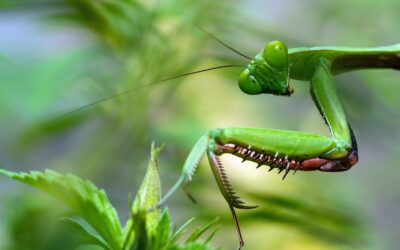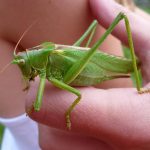Praying mantises are a unique and fascinating group of insects known for their distinct appearance and predatory behavior. They belong to the order Mantodea, and there are over 2,400 known species of praying mantis found throughout the world. These insects are known for their elongated bodies, triangular heads, and powerful front legs, which they use to capture and hold onto their prey. Praying mantises are carnivorous and feed primarily on other insects, but some larger species have been known to eat small vertebrates such as lizards and birds. They are also known for their remarkable ability to camouflage themselves and blend into their surroundings, making them difficult to spot. Praying mantises have a complex life cycle and undergo a series of molts as they grow and develop. Females of some species are known for their cannibalistic behavior, where they may eat their male partners during or after mating. Despite their fearsome reputation, praying mantises are considered beneficial insects and can help to control pest populations.
What is a praying mantis?

A praying mantis is an odd-looking insect, with a triangular head, and bulging eyes, they are completely harmless and fascinating creatures to look at.
Praying mantises belong to the Mantodea family and are closely related to cockroaches and termites. There are over 2000 species of praying mantis, and they live predominantly in tropical climates.
Difference between male and females
- If you turn a praying mantis over the abdomen has segments that run from top to bottom, the females have six segments, and the final segment is large.
- Males have eight segments, and the last segment is small.
- Males tend to have a slender body and females have a wider body.
- Males have long wings and can fly; females have short wings and cant fly.
- The males have longer thicker antennae; the females have shorter antennae.

Keeping praying mantises as pets

Keeping praying mantises as pets can be very a very rewarding experience. They are fascinating creatures that don’t require too much effort to take care of.
Unlike leaf insects who eat only leaves praying mantises eat other insects, you will need to provide a variety of insects for your new pet.
Enclosures
The type of enclosure you choose for your mantis is entirely up to you. You just need to make sure that your mantis has enough room to roam and it has plenty of ventilation.
You can choose a large jar, transparent storage box or a purpose-built glass tank or terrarium. There really are no rules to housing a mantis as long as you provide plenty of space and ventilation.
You will need to furnish your enclosure with decorative items like twigs or branches and flowers. You can use real ones or fake, just make sure they are not harmful to your mantis.

Heat and humidity

Depending on the species of praying mantis, you will need to provide a heat source and humidity. Some mantis species live in desserts that are hot without moisture. Others live in damp forest areas.
You will need to research the species you purchase to see its natural habitat and try to recreate it in your enclosure. If your mantis requires heat and humidity, you can provide these using a heat lamp or a heat mat and using a misting spray bottle.
Light bulbs
If you use a light bulb to heat the enclosure, there will need to be at least a 10cm gap between the bulb and the top of the setup; this will stop any mantises from overheating if they get too close to the bulb.
If you choose to use a light bulb then ideally you should put it on a timer. The lights should be switched off for a few hours at night replicate a natural habitat.

Substrate

There are many options to choose from when looking for substrates you can use; potting earth, shredded wood, tissue paper, vermiculite, pieces of bark or even sand.
Substrate helps to keep moisture in the enclosure stable, but you want to make sure that it doesn’t get mouldy as this can be harmful to your mantis.
Heat mats
As with most insects If you are using a heat mat, you should either position it on the backside of your chosen setup or under one section rather than underneath the entire setup. If you are using a heat mat, you will need to regulate the heat using a thermostat.

Feeding your praying mantis
Your mantis is a predator that only feeds on live insects. They will camouflage themselves, staying completely still, ambushing unsuspecting prey that might happen to wander near them.
Some mantis species can eat fish, frogs and lizards too they are also partial to feeding on other mantises if food is scarce. Small mantis can eat, fruit flies and springtails moving up to bigger insects like; flies, roaches and crickets. A general rule of thumb for feeding your young mantis is that the prey should be at least half the mantis’s size.
Unlike regular pets praying mantises do not need to be fed daily, they are usually fed every 3-4 days. Large mantises can be fed every 5-7 days depending on the prey’s size.
One thing to be mindful of is the prey you give doesn’t have somewhere that it can hide away from the mantis. If your mantis cant see it, it cant eat it. If this happens, you can present the food to you mantis using tweezers.

Important information
Your mantis is a predator that only feeds on live insects. They will camouflage themselves, staying completely still, ambushing unsuspecting prey that might happen to wander near them.
Some mantis species can eat fish, frogs and lizards too they are also partial to feeding on other mantises if food is scarce. Small mantis can eat, fruit flies and springtails moving up to bigger insects like; flies, roaches and crickets. A general rule of thumb for feeding your young mantis is that the prey should be at least half the mantis’s size.
You might also Like
The Benefits of Praying Mantises in the Garden
This article explores the fascinating world of praying mantises, their predatory behaviour, diet, and benefits of having them in your garden.
Why Does A Female Praying Mantis Bite The Head Off Its Mate?
An interesting insect to learn about is the praying mantis, which is certainly unique when it comes to its mating process.












